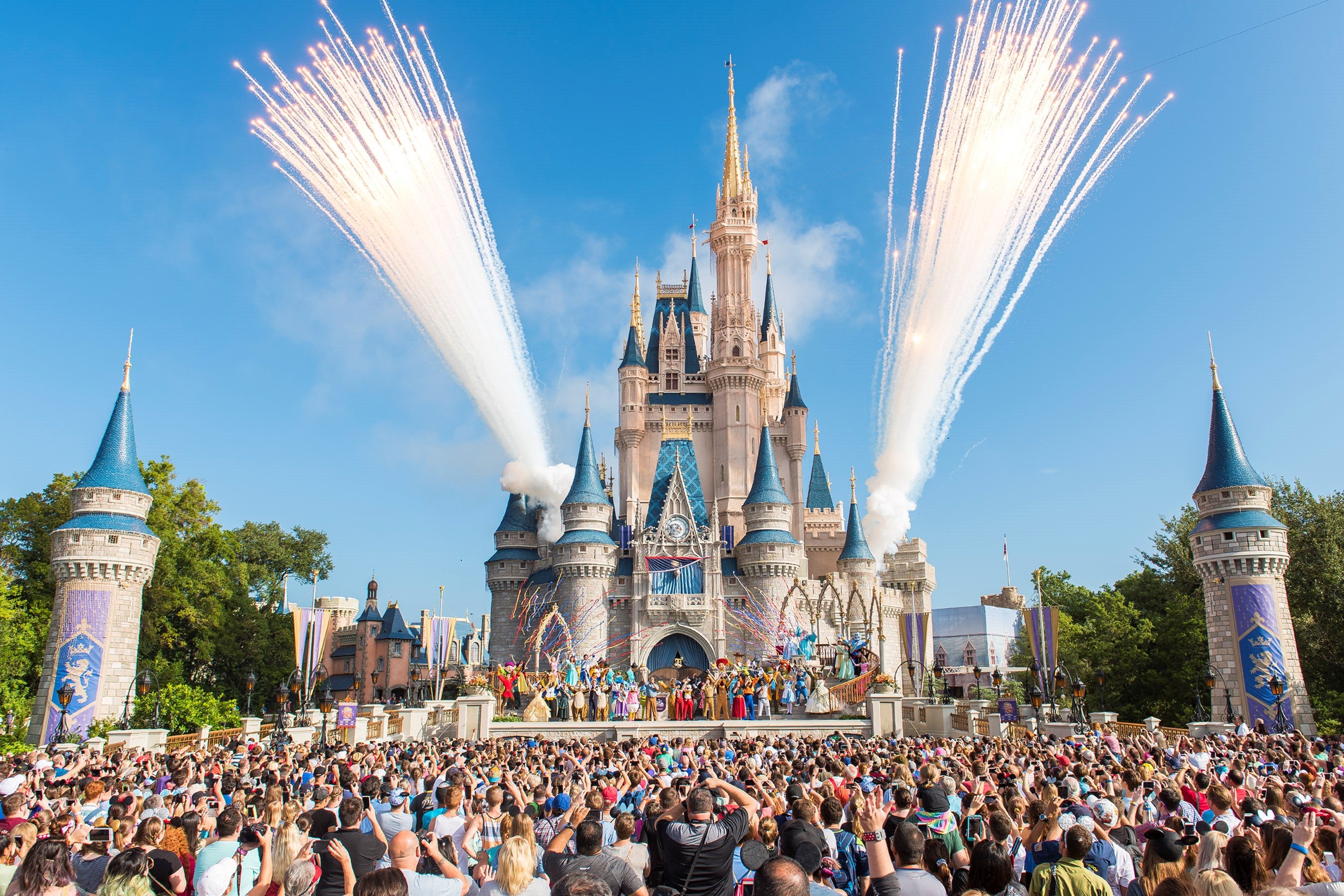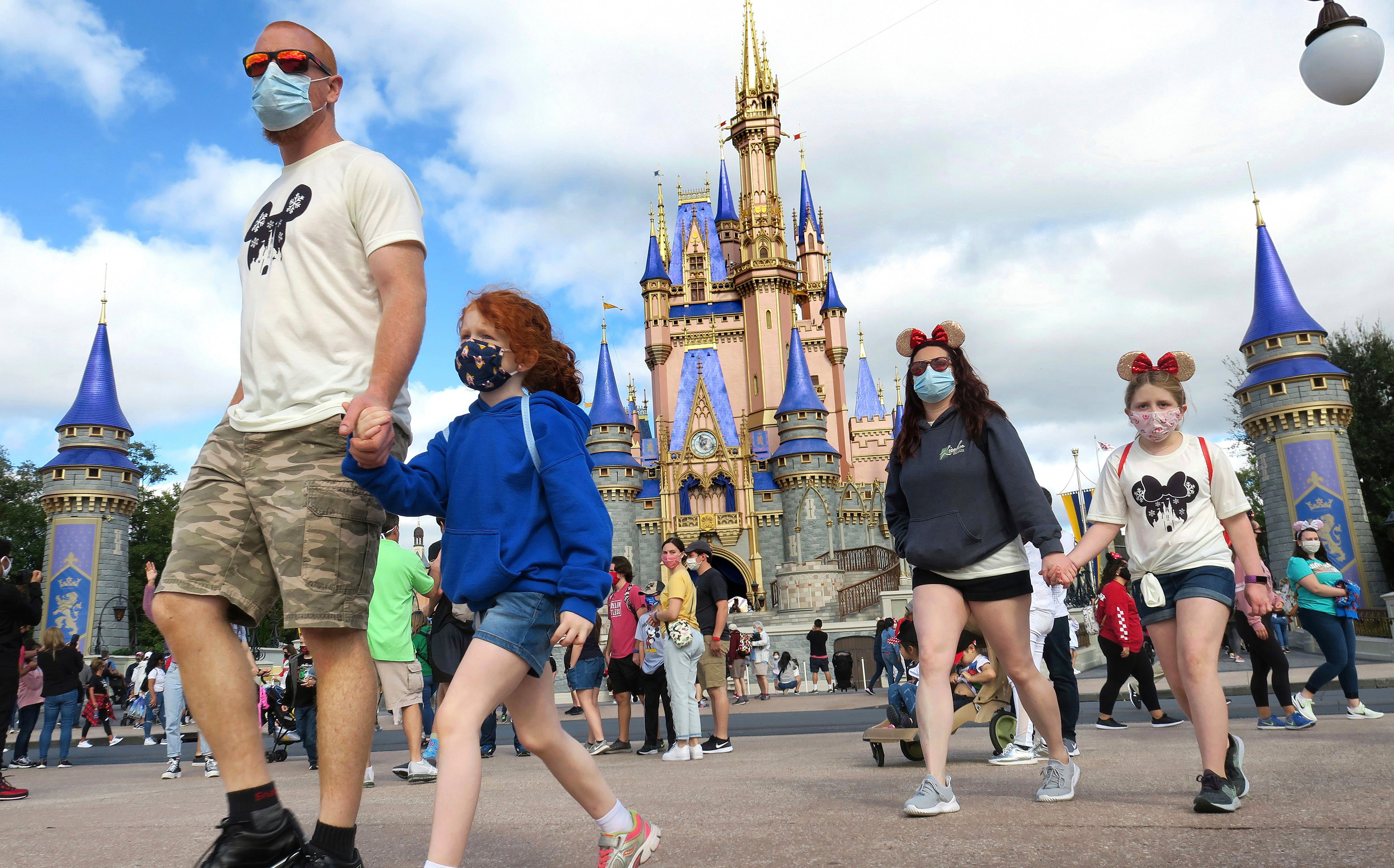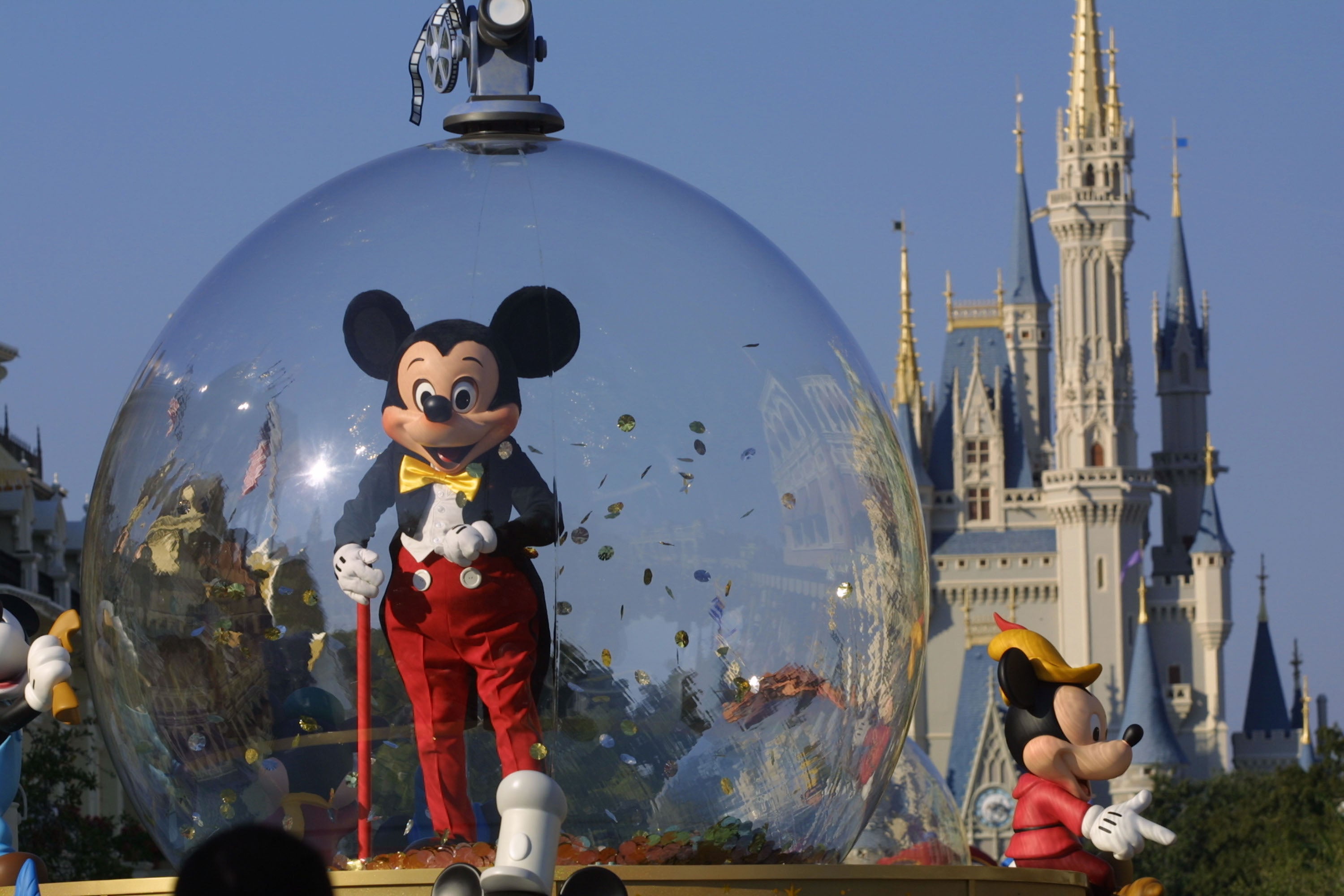Secrets of Disneyland, from rules for performers to hidden rooms, mystery train carriages and ‘real’ skeletons
TikTok videos cast spotlight on resorts’ mascots and many regulations they must abide by to avoid breaking illusion for young visitors, often in challenging circumstances

Two recent viral news stories arising from TikTok have cast fresh light on the pressures on staff working as character performers at Disneyland and Disney World resorts.
In the first, Evan Sneed published resurfaced footage from 2015 of a guest harassing an actor playing Gaston from Beauty and the Beast (1992) until the posturing huntsman asks her to leave, telling her: “You’re done.”
The clip provoked a heated debate over which party was in the right, with Mr Snead imploring the public to be more considerate towards performers, later explaining to The Independent: “I always like to put out small PSAs to people to simply treat Disney cast members with respect and to treat them the way they would like to be treated.”
In the second, former Disney character performer Sarah Daniels took questions from her followers on the video app about her career and revealed that married men would frequently hit on her when she appeared in the park dressed as Tinker Bell the fairy from Peter Pan (1953).
“I feel like if dudes are going to be creeps and hit on you, they’re going to hit on you whether or not you’re a character or not,” Ms Daniels reflected. “But there were many moments, especially as Tinker Bell, where I had married men hand me keys to their hotel room and tell me where they were staying.”
The first Disneyland theme park was opened in Anaheim, California, in 1955 under the direct supervision of its namesake, Walt Disney, creator of Mickey Mouse and the groundbreaking fairytale animations Snow White and the Seven Dwarfs (1937), Pinocchio, Fantasia (both 1940), Dumbo (1941), Bambi (1942) and Cinderella (1950).
Disney personally ensured that every effort was taken to make the park “the happiest place on earth” and prevent its illusions being broken, allowing spellbound children to feel wonder at the spectacles on show without being disturbed by unwelcome intrusions from the adult world.
Mike Fox, author of The Hidden Secrets & Stories of Walt Disney World (2016), has said that a “deep commitment to the guest experience [is] instilled within the company”.
“For Walt, it was all about the story. To see a cowboy from Frontierland in Tomorrowland, it just ruins the story,” he told Business Insider, alluding to one of the many rules governing performers’ behaviour in the parks’ grounds, prohibiting them from venturing outside of the appropriate realm for their character.
Performers are carefully auditioned for their parts, asked to sing and learn choreographed dance routines, with improvisatory skills considered a particular asset.
“When you’re talking to Cinderella, and say, ‘Hey, let me take a picture of you on my iPhone,’ and she says, ‘What is an iPhone?’ – she’s playing a role and her job is to maintain that role, to maintain that entertainment, maintain that story,” Mr Fox said.
The theatrical language surrounding the job is telling. The fact that “cast members” are said to be “onstage” when appearing in costume before the public makes clear that employers are expected to consider their work as an acting gig in which it is vital they do not break character.

“They very much stressed that this is an experience. It’s not your experience, it’s the guest’s experience. You have to provide the best show that you can. It’s stepping into a role,” ex-character performer Devin Melendy has said of her time at World Disney World in Orlando, Florida.
Other highly specific secret rules governing the conduct of performers include their not being allowed to point when giving directions (a less “rude” two-fingered indication, as favoured by Walt Disney himself, is preferred) or to answer “I don’t know” when asked a question by guests, the response deemed too human, not helpful to either the guest or to the character’s mystique and a conversational dead end.
They are not allowed to ask any celebrities they might encounter for autographs, no matter how starstruck they may be, and euphemistic code words are deployed when reporting clean-up incidents to custodians, such as “code V” or “protein spill”, uttered to summon a colleague to address a pool of candy-coloured vomit, just as it might be among officials on public transport.
A “405 in Line 2”, incidentally, is allegedly used to draw attention to a particularly attractive person spotted in a queue.
Specific characters might also have their own rules: the Beast, for instance, only appears during meal times at the Be Our Guest Restaurant in Disney World’s Magic Kingdom other than during parades, according to Reader’s Digest.
This is consistent with the logic of the character children will be familiar with from the film – a thoughtful detail that also explains why two versions of the same character are never seen in the park at the same time. To do otherwise might provoke awkward questions from perplexed kids and inspire dark doubts about the whole venture and much else they might have been told about Father Christmas or the Tooth Fairy.
The determination never to break the illusion is built into the design of Disney’s parks in Anaheim, Orlando, Paris and Tokyo.
In Orlando, for instance, Cinderella’s Castle was reportedly built to be south-facing so that the sun would never sit directly behind it and the fortress stands apart from all other high structures, ensuring that its tower is never cloaked in shadow and will remain well-lit for family photographs.

Because of that particular resort’s setting in the balmy, swampland atmosphere of central Florida, it also had to be constructed without decorative pools of standing water in place to avoid attracting mosquitoes. Should the parasites be tempted to descend anyway, a spray of garlic extract is deployed around the grounds to dissuade them, its scent too subtle to be detected by humans.
Another airborne irritant, noisy aeroplanes, are likewise never seen over Disney resorts as a permanent no-fly zone is in place to keep them out while, below ground, a network of tunnels or “utilidors” operate to allow staff and performers to get around easily, passing on the quiet and out of sight. To further protect the veneer of perfection, litter and garbage is ferried away unseen through these same discreet routes after collection.
Another interesting aspect of the design of the parks that might not be immediately obvious to first-time visitors is how many “Easter eggs” are built into its infrastructure.
Hidden Mickey Mouse iconography is everywhere for the eagle-eyed to spot and there are any number of secret rooms around that are not generally open to the uninitiated, from the hidden hotel suite inside Cinderella’s Castle in Anaheim, available exclusively to competition winners and the specially invited, to the makeshift and off-limits basketball court for employees in an attic above the same park’s Matterhorn Bobsleds ride.
There’s a secret train carriage on the Orlando resort’s Disney Railroad named the Lilly Belle in tribute to the founder’s wife, which is decorated as a Victorian parlour, houses rare memorabilia and is only open to guests in the early morning.
There are secret items on the menu at resort restaurants, according to Cosmopolitan, which recommends the ice cream nachos at Frontierland’s Golden Horseshoe, the loaded tater tots at the River Belle Terrace and the mac ‘n’ cheese bread bowl at the Wharf Cafe in the California Adventure zone.
Secret time capsules have been buried in front of Sleeping Beauty’s castle in Anaheim since 1995 beneath Buena Vista Plaza in California Adventure since 2012 but, perhaps most mysteriously of all, an exclusive dining society, known as Club 33, is in operation up the top of a set of winding stairs in New Orleans Square at the same park, its front door painted an intentionally innocuous shade of pale green to discourage snoopers.
And the rides? One of the most astonishing rumours, again per Cosmopolitan, is that the original Pirates of the Caribbean ride, which inspired the Johnny Depp blockbuster franchise, had real skeletons in place when it opened in 1967, acquired from UCLA Medical Center. Whether that was ever true is open to question, but plastic replicas stand in their place these days, rest assured.
Some other tidbits you might enjoy include the revelation that there are no bathrooms in the Magic Kingdom’s colonial-era Liberty Square as a concession to historical accuracy, Tomorrowland’s plants are edible in keeping with a future of sustainable agriculture and Main Street Railroad’s lost property shelf contains items supposedly left behind by other Disney characters like Aladdin and Mary Poppins.

Those screams you heard in the Tower of Terror were pre-recorded, sadly, that enticing fresh bread smell you pick up near eateries is artificial and piped in and so resourceful is Disney towards recycling its animatronic figurines that one-time members of the Hall of Presidents are apparently visible among a crowd of stargazers at Epcot’s Spaceship Earth ride in Bay Lake, Florida.
What else? Just-off Stars and Stripes hang from the flagpoles to get around federal flag laws and the poles themselves double up as lightning rods to keep visitors safe during storms, plainclothes security personnel patrol the crowds at all times dressed as holidaymakers and apparently-spontaneous character performances might be ushered into action to attract crowds away from busy queues for rides.
Oh and costumed staff are, thankfully, no longer issued with communal underwear (yep, you read that right), as The Los Angeles Times reported was once standard practice, with all the associated horrors you might expect that policy to entail very much a reality.
“Working at Disney isn’t magical all the time,” Meghan O’Neill, another former cast member, told Business Insider. “You work long hours in all types of weather dealing with guests who have high expectations.”
Pursuing that line of thought, BuzzFeed earlier this year asked commentators for their memories of working at Disneyland and Walt Disney World and were rewarded with a glorious slew of scurrilous and unverifiable anecdotes.
Tales of inadvertent elephant erections and performers throwing up inside their Goofy heads because of the sweltering summer heat were prevalent but surely the winner was a gentleman who reported a group of adults wolf-whistling at Minnie Mouse, only for Mickey to respond in his trademark falsetto: “If you look at my girlfriend again, I’m gonna pop ya!”
Evan Snead is quite right. This is a hard line of work and deserves our every respect.
Join our commenting forum
Join thought-provoking conversations, follow other Independent readers and see their replies
Comments


Bookmark popover
Removed from bookmarks